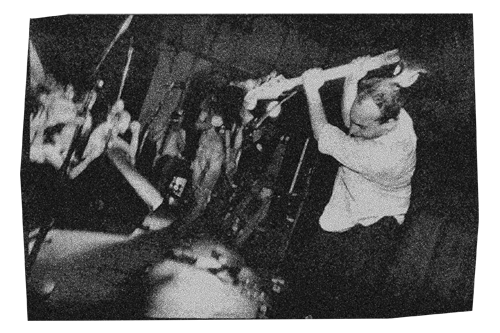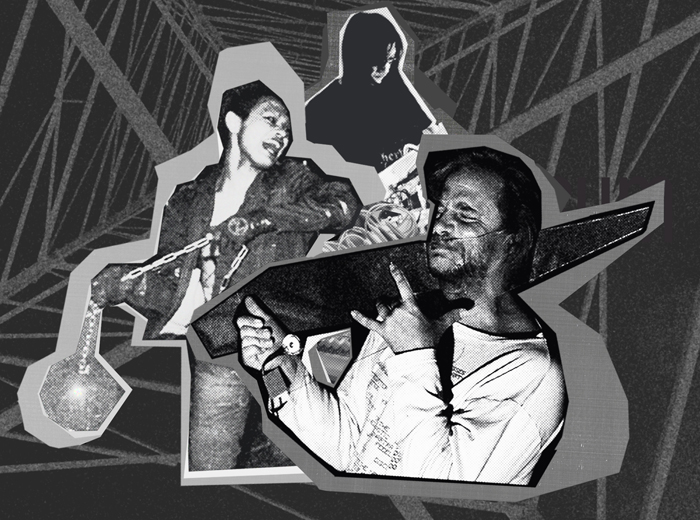American performance art group Survival Research Laboratories (SRL) builds, programs, battles, and explodes their own robots. Ever since its 1978 inception by mechanist and sculptor Mark Pauline, SRL’s performances stand as testaments to the group’s notoriety, documented in gritty archives, CDs, and VHS tapes. In a 1985 SRL tape, “Extremely Cruel Practices,” SRL’s audience huddles in terrified excitement. Under the 4th Street Bridge in Los Angeles, Pauline’s galvanized nightmares shovel shrapnel, piling ash and rebar mere yards from a human semicircle. Cranes catapult firebombs across the concrete ground. Plumes of smoke rise, Marshall stacks blare AM radio signals…SRL’s performance is a mechanical horrorshow, melting into an inferno of science and industry.
The audience loves it.

How exactly do we “get” danger music?
Tchaikovsky infamously scored cannons in the monumental ending to his 1812 Overture. The 1956 Georg Solti-conducted Decca recording of Richard Wagner’s Der Ring des Nibelung. features a hammer striking an anvil: a moment that BBC Music Magazine once considered “the loudest sound ever recorded” in classical music. From cannons and anvils to Steve Reich’s sampled street construction on his 1995 composition, City Life, abrasive noises have intrigued artists and audiences beyond the realm of the artsy-fartsy coffeehouse. As Canadian artist Tim Hecker’s dissertation illustrates, referencing the 11,000 singers and 100 anvils in the 1869 National Peace Jubilee, “The Jubilee organizers intuited that the power of sound was not what it could be. Celebrations could be louder. Music could have more impact. The walls could shake more.” Bougie, rococo classical culture contrasted with the performative sensation of explosive sound. Punk and heavy metal stripped these flowery attitudes from musical discourse. United by power chords and ripped jeans, punk and metal refracted performance through one ugly lens: noise.
Early figures within industrial, power electronics, and noise music took a decidedly aggressive approach to performance art, using danger as a medium. European noise progenitors such as SPK, Throbbing Gristle, and Einstürzende Neubauten repurposed electronics and scrap metal for instruments, whacking shopping carts before it was cool. New York’s no-wave scene injected the city’s burgeoning clubs with punk’s noisy aesthetic through early Sonic Youth, Filth-era Swans, and the artists on Brian Eno’s rambunctiously-groovy No New York compilation. Even “high-brow” institutional art was no stranger to danger. Western Fluxus artists and the Viennese Actionist movement shocked art institutions by hosting oddball “happenings,” manipulating the human body. Actionist Günter Brus went for a stroll while completely painted in black-and-white for his absurd 1965 public performance, Vienna Walk. Fluxus electrified New York’s art scene with the coyote-taming, clothing-cutting performances of Joseph Beuys and Yoko Ono. Early avant-garde happenings and noise music concerts weren’t exactly a bunch of pretentious, encyclopedic snoozefests; they were jolts of energy.
Big Black, a Chicago noise rock trio fronted by Steve Albini, lit fireworks onstage. A 1987 VHS of Big Black’s final concert in Seattle’s Georgetown Steamplant, The Last Blast, ends with a harrowing performance of “Jordan, Minnesota” from their 1986 album, Atomizer. In between his E-mu Drumulator’s bursts, Albini unbuckles his guitar, shrieking into its metal pickups. All three of the band members slam their instruments over one another, piling splintery remains before they stomp off stage.

“I thought I told you to shut up!”
Albini lights a fuse over the guitars. The fireworks sizzle and pop, flinging shrapnel into the audience. The fireworks consume the venue until the noise dies down, and the crowd erupts. Credits roll, and the audience leaves, but Albini is still squirming and stomping into his Marshall stacks, teething into his machine’s failures.
Kurt Cobain of Nirvana attended The Last Blast in person (you can even see him in this frame of the tape.) Disregarding the fact that Albini produced the band’s 1993 album, In Utero, Nirvana and Japanoise exploded into 90s public consciousness simultaneously. Japanoise’s Western influence in particular exploded with 90s youth apathy. Western noise artists such as The Haters and Prurient banged and shrieked under the commercial dominance of Nine Inch Nails and Attitude-era WWE. Cobain’s appearance in The Last Blast is a fascinating example of how danger can fascinate just about any concertgoer. Before Nirvana and Seattle’s grunge scenes dominated the 90s cultural plane, independent scenes were the only sources for this special brand of dangerous performance. To counter WatchMojo, the suggestion that “danger musicians want to prove that music is inherently dangerous” completely disregards the audience’s takeaways – after all, they came to see the performance. To any joking observer, the surface-level appearance of a dangerous performance is the biggest factor against attending the shows.
Because… why would you?

A sort of sly attitude both allures and mocks danger music critics. Without any form or structure, danger music is a genre that poses a threat to tradition. Some dismissive #2 placement of danger music as one-in-ten on a Sears Catalogue of “weird music genres” reveals an ugly truth behind this type of criticism: the notion that art is exclusive. Outsiders react to these independent genres, but they imply the same tiring, monotonous conclusion that dulls all surfice-level criticism of experimental art: pretentiousness.
I was fifteen. Nirvana and Big Black were my two biggest obsessions. Though I was incredibly reserved, I loved art and music. I watched “Top 10 Weirdest Music Genres” on my aunt’s laptop, my mind having just been stunned by Homestar Runner’s April Fool’s Day return. WatchMojo’s mere mention of niche “weird genres” such as vaporwave, lowercase, extratone, Japanoise, and danger music led to a litany of Googles and album playthroughs. As an outsider, I couldn’t understand why danger music had to be visceral to be effective. While Hanatarash was certainly far more threatening than the Atomizer and In Utero .mp3 rips that nurtured me, I felt that I would never really “get” this type of music. Burdened with acne and embarrassment, I was at a turning point in my life, not really sure about where I was going or what I was doing, and trying on philosophies and genres like clothes.
“Fun.”
Beyond the confines of the gallery, our pixel-locked grid of the Internet can be a tool for discovering art – we have the tools to discover art that argues with us, that doesn’t simply exist for historical novelty but instead screams from the past. The idea that people do care about this music enough for a mere mention, the idea that records have been archived for others to see these artists…to me, that archival attitude is incredibly exciting about danger music. The thought of some other unsure teenager discovering challenging art inspires me deeply. The fact that we have photographic proof of Hanatarash performing with an excavator is incredibly useful for discussions on how art can be performed. Einstürzende Neubauten’s documented grocery cart performance makes me think of all the objects in my home that I could use as an instrument (if you were ambitious enough, you could steal a shopping cart from your local Walmart and play it through fifteen different guitar pedals. As long as you hit record.) Thinking differently about music’s functionality is danger music’s mission statement. Rather than treating it as a hostile sport, danger music should be approached as a performance to be seen, and an event to enjoy and participate in.
WatchMojo’s mockery is true. Danger music is “fun.”
In every sense of the word, the “fun” of danger music is in its dangerous nature. Exploding machines. Banging anvils. Tearing it all down, and ripping it all up. Destroying the whole thing, diesel and wheels. Standing, open-jawed, in the mouth of the dangerous machine, firing cannons and launching fireworks while the orchestra plays on.
Codex on Linktree
